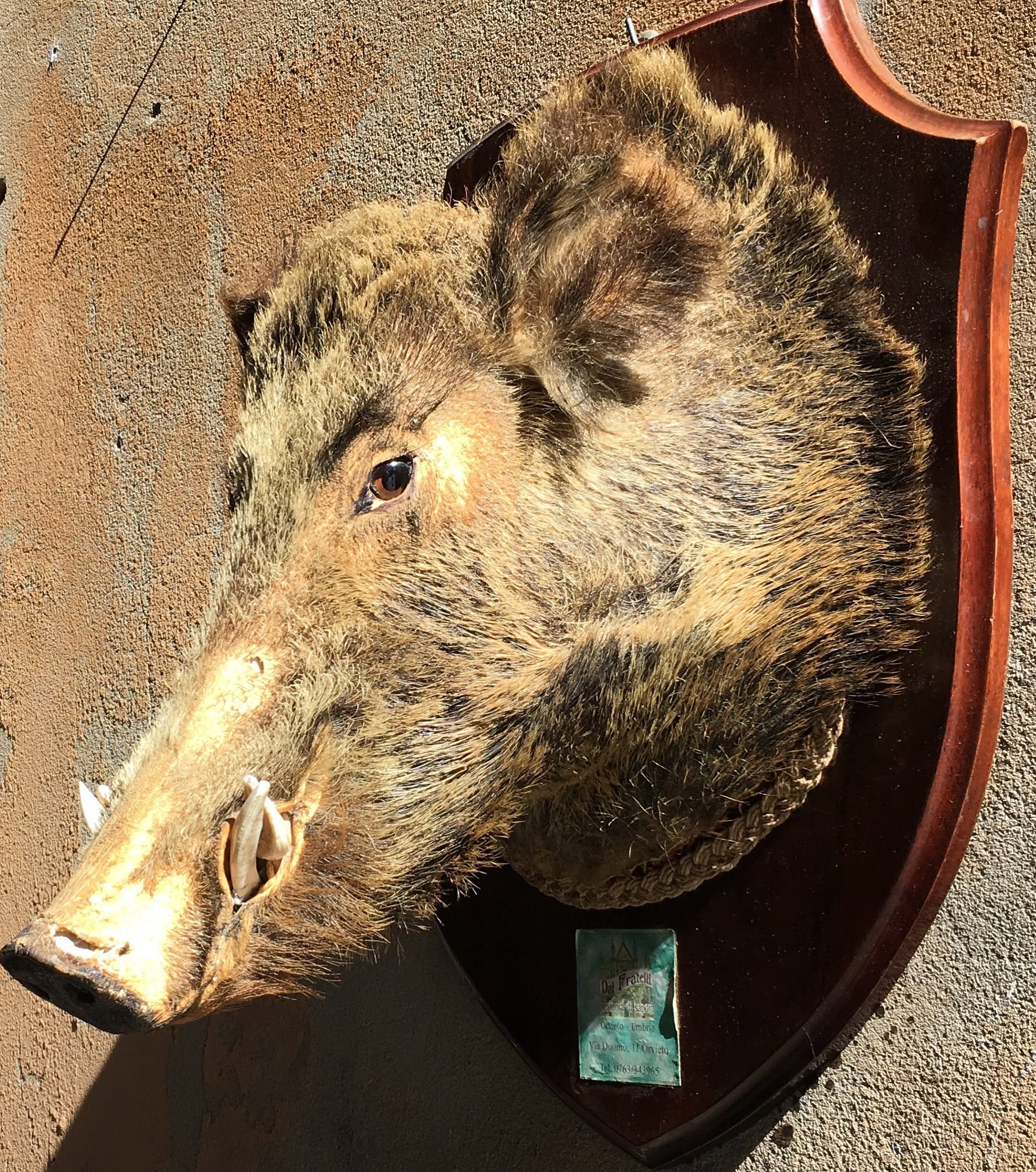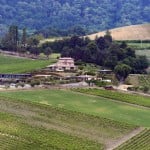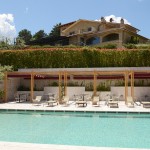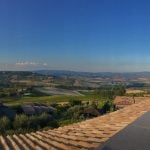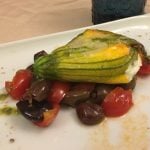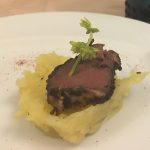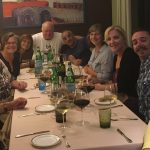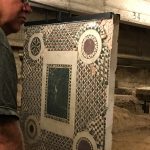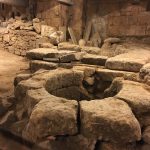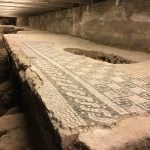The Umbria town of Orvieto sits atop a plateau of tufa rock—consolidated volcanic ash that we would call “tuff” in English. The rock was thrown from the large crater that is now Lake Bolsena, which we visited four days ago.
Our home base for the next two days is Altarocca Wine Resort. Its buildings are made of this tufa rock, as is most everything else in the area.
- Altarocca sits atop a valley of vineyards
- Altarocca pool in Orvieto
- View of the valley from my balcony at Altarocca
While our Siena agriturismo Podere la Strega was drenched in Old-World charm, Altarocca is all about modern decadence. It boasts an outdoor swimming pool and Jacuzzi, a spa with whirlpool, Turkish bath, and sauna… nestled into the center of a winery with four-star food.
And oh, the food…
Altarocca tasting menu
Dinner is the resort’s tasting menu: pork liver on mashed potato (the waiters called it “smashing” potato), stuffed zucchini flower, onion soup, Tagliatelle with duck ragu, lamb ribs with pepper and chicory, and a dark chocolate terrine with apricot sauce.
Although we’ve been in Italy for nearly a week now, our stomachs are still not on Italian time. An 8:00 meal feels like midnight to me and no doubt like the middle of the night to Los Angeles resident Christin, a human resources executive there.
The bread-with-butter-before-dinner controversy
If you’ve been following this series closely you know that eating bread before the main course arrives is a running joke between the Americans and our Roman born-and-bred guide Enrico. Italians simply don’t do it, but of course Americans do.
The wait staff makes the “mistake” of bringing bread to the table before our meal. Dan is married to an Italian-American and therefore “knows better,” but his stomach prevails as he bravely makes his move on the bread basket. As Enrico begins chiding him—and lucky for us his attention is diverted to Dan—we all stealthily grab a slice.
- Stuffed zucchini flower
- Pork liver over “smashing” potato
- Our tour group at dinner, Altarocca Wine Resort
Butter on bread is another point of American transgression against Italian foodways. Denean from Louisiana quietly asks the waiter for butter, which we haven’t had in five days. When it arrives, we all ask her to pass it along. Like an indulgent grandfather, Enrico pretends not to notice our “English” behavior—that’s how he thinks of butter on bread, as an English peccadillo.
When he and the other smokers go outside for a lungfull, the rest of us brainstorm ideas for a thank-you present for Enrico, whom we have come to love despite—or perhaps because of—his staunch upholding of the Italian gastronomic tradition.
We decide it must have something to do with bread. A fancy bread basket? A butter dish? It must be something uniquely memorable of our experience. We agree to keep our eyes open the next day in Orvieto.
Orvieto
The locals call Orvieto La Rupe—“The Rock,” and it is seated above the vineyard-striped valleys surrounding it.
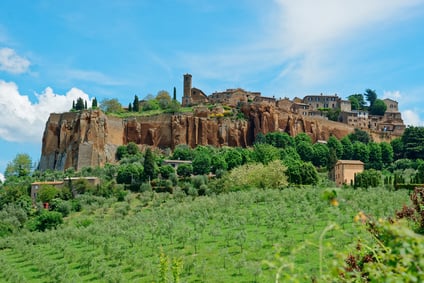
The town of Orvieto in the Umbria region of Italy sits atop volcanic tufa rock
We approach La Rupe in morning traffic, making an unbelievably-sharp right hairpin turn from a dead stop on a hill. Enrico warns us with a hand signal and his own example how to approach it. I am second behind him and as I look to my left, sun in my eyes, I come to a halt in traffic to allow right-of-way to traffic to pass. I can’t make both the climb and hairpin without backing down five or six feet for runway, and because we’ve all been riding together for several days everyone behind me edges back accordingly.
Nice teamwork, eh? When we pull into the parking lot my friends are very gracious about my travail.
Archeology tour of Sant’ Andrea
- Roman panel in Sant’ Andrea
- Well in Sant’ Andrea
- Etruscan and Roman treasures
Enrico’s original plan for our Orvieto visit did not include a tour of Sant’ Andrea (Saint Andrew’s), but when a friend told me of Etruscan ruins underground and the possibility of a guided tour, I asked Enrico if we could add it to our itinerary.
Everyone else agreed and he arranged it with the archeologist, giving us a fascinating glimpse of not only the Etruscan forum and their building technologies, also the 6th century basilica. See the video of our archeologist at the top of this post.
The ruins confirm that Etruscans inhabited Orvieto from roughly 900 BCE until the 3rd Century BCE. To mark time for my fellow Americans, this means the Etruscan society started at about the same time as the Early Woodland period in North America (Central Europe’s Iron Age). It continued until the time the Roman Republic fought its epic battles with Carthage (264 BC to 146 BC).
My tour of Sant’ Andrea further fuels my interest in this ancient people. Next time I visit I’ll tour the Etruscan museo, “Claudio Faina” near the Cattedrale di Santa Maria Assunta.
Food shopping in Orvieto
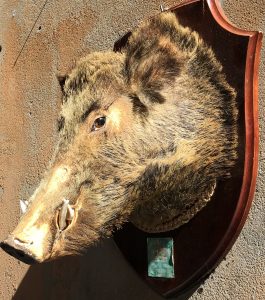
Boar’s head at Norcineria Dai Fratelli
After our fascinating archeology tour, we spend the morning strolling Orvieto, surreptitiously scanning the shops for Enrico’s gift.
After lunch several of us are with him when he gets the bright idea to buy meats and cheeses for a picnic on our way home to Rome tomorrow. He knows just the place, Norcineria Dai Fratelli. Visitors can identify it by looking for the mounted boar head to the right of the entryway.
Next door is a pottery shop that has a basket of wares outside, including a small butter dish that Jo and I think is the perfect memento for Enrico. We plan to give it to him at our farewell dinner.
I cover for her absence with the group as we follow Enrico into Norcineria Dai Fratelli. Inside is a now-familiar sight—wild boar sausage hams hang from the ceiling, a nub of femur bone staring at you, and fur intact. Enrico selects sausage and cheese with the enthusiasm and expertise of a proverbial kid in a candy shop.
Every time I step into a butcher shop in Italy I’m reminded of where “real food” comes from, in contrast to the styrofoam and plastic trays that disguise food origins back home.
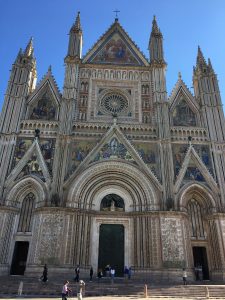
Orvieto’s duomo, Cattedrale di Santa Maria Assunta
Do you know that some schoolchildren can’t identify basic foods like tomatoes, mushrooms, potatoes and cauliflower? For more on this point, watch Jamie Oliver’s TED talk and prepare to be amazed.
I’ll tell you more stories from Italy this year, since I’m returning to ride my motorcycle through Tuscany, Corsica, and Sardinia in 2017. Subscribe using the purple button above and you’ll never miss an installment of the story.
Here is the beginning of the series. The next installment is from Umbria’s Lake Corbara towns.
